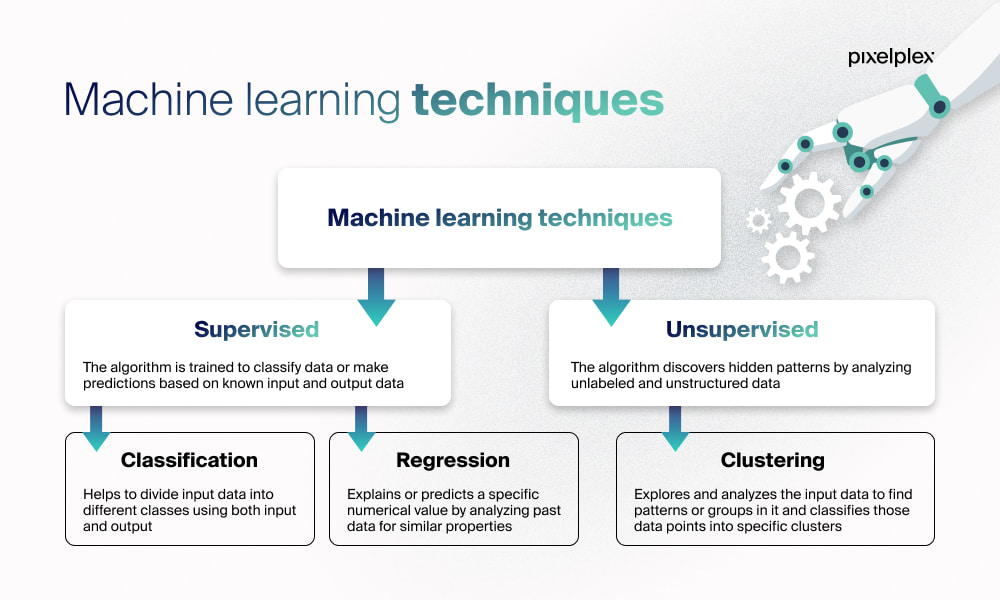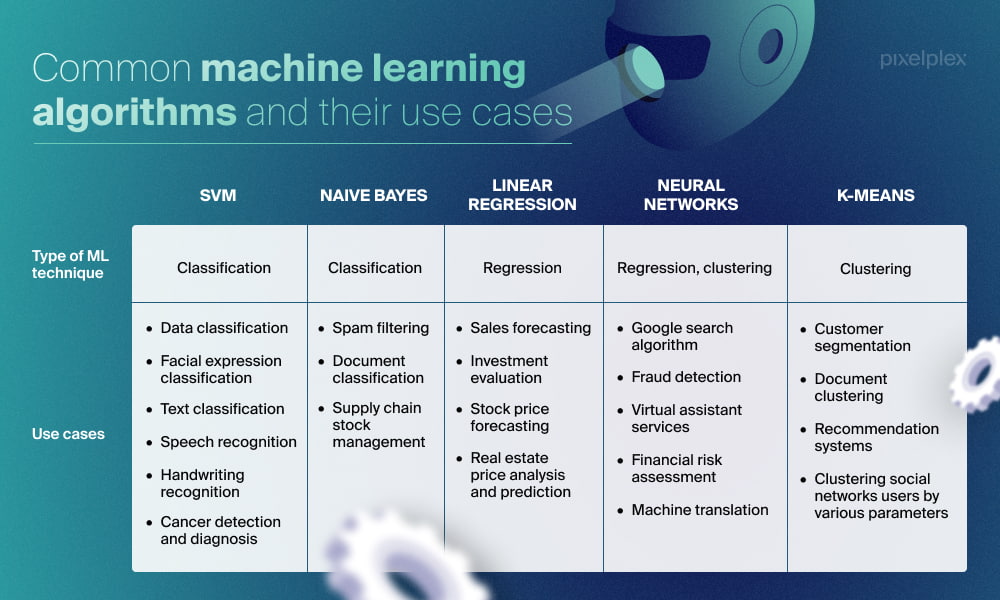All of us make mistakes and (try to) learn from our experiences. Machine learning is pretty similar, but unlike us, machines can learn and improve automatically. There exist many types of ML techniques, all with different learning methods. What are those?
Machine learning (ML) has come a long way. It started as an algorithm that mimicked human thought processes. This idea was first described by logician Walter Pitts and neuroscientist Warren McCulloch in 1943. It has now emerged as a solid tech with applications in healthcare, eCommerce, finance, cybersecurity, digital marketing, and even food service.
These days, machine learning is a steadily developing field. According to Fortune Business Insights, the global ML market is expected to grow from $15.44 billion in 2021 and $21.17 billion in 2022 to $209.91 billion by 2029.
Let’s take a closer look at how machine learning works, what types of technology are out there, what machine learning techniques are used most frequently, and how they differ from each other.
How does machine learning work?
Machine learning uses computational methods to analyze data, identify patterns, learn from these patterns, and make predictions.
Basically, ML imitates humans — the more we learn and experience, the better and faster are the decisions and predictions we make. In the case of ML, it is “fed” with data. So, the more data it receives and processes, the more accurate the result will be.
Machine learning categories
The majority of machine learning algorithms fall into the following categories: supervised machine learning methods, unsupervised machine learning techniques, semi-supervised learning, and reinforcement learning. The first two are the most common.
Supervised learning
Supervised learning implies that there is known data (input) and known responses to it (output), and the algorithm is trained to make predictions or classify data based on this information.
This type of machine learning requires large amounts of data. In the algorithm training process, the ways of processing data can be constantly adjusted and corrected until you get the desired outcomes. Once the algorithm is well-trained, it can generate reasoned responses to newly added data.
Unsupervised learning
Unsupervised learning works with unlabeled and unstructured data and helps discover hidden patterns in it. This type of learning requires neither large amounts of data nor human intervention.
Unsupervised learning is often used to categorize data or, for example, to find patterns in customer behavior and to recommend products that are similar to those already in the cart.
Semi-supervised learning
Semi-supervised learning makes use of all available data — usually small chunks of labeled and bigger amounts of unlabeled data. Part of the data can be classified manually. Then the algorithm will be able to sort the rest of the data in a more accurate way.
Reinforcement learning
Reinforcement learning trains itself from its own experience, without any training dataset. In this type of ML, the algorithm learns to behave in an uncertain environment, making various decisions and receiving feedback on its actions — positive or negative.
Check out PixelPlex’s portfolio of projects where we have successfully implemented ML and AI technology
3 main techniques of machine learning

The three most used machine learning techniques are classification, regression, and clustering. Classification and regression represent supervised learning, while clustering comes under the category of unsupervised ML. Let’s dive a little deeper and look at the differences between the three.
1. Classification
Classification is a machine learning technique that helps to divide input data into different classes. For example, it can decide whether there is a bicycle or a truck in a picture, or if an email is spam or not, or whether a tumor is cancerous or benign, and so on. Classification techniques can also help predict whether or not an online customer will make a purchase.
Companies often choose this type of ML technique when they need to automate and speed up workflows. By having data automatically classified, employees can focus on more important and complex tasks.
2. Regression
Machine learning regression methods are used to explain or predict a specific numerical value by analyzing past data for similar properties. For example, regression algorithms can assist businesses with forecasting retail demand, real estate prices, and required electricity load. They can even help optimize food procurement for restaurants.
3. Clustering
Clustering is the most popular type of unsupervised machine learning. This technique does not use any output information and does not require labeled data. It only explores and analyzes the input data to find patterns or groups in it and eventually classify those data points into specific clusters.
The clustering machine learning technique is especially useful in object recognition, market research, marketing campaigns, and recommendations for Internet users.
Find out more about how machine learning is applied in eCommerce and how it benefits this industry
Most common machine learning algorithms and their applications

There are dozens of different algorithms that fall under classification, regression, clustering, or other types of ML methods. Now it’s time for us to focus on the most popular among these machine learning algorithms to understand what they do and how they are used.
SVM
The SVM algorithm belongs to the classification machine learning method, but it can also be applied to regression.
The algorithm works really well in high dimensional spaces and can process all types of data: structured, unstructured, and semi-structured. However, it is not recommended for use with large data sets since it will take a lot of time to train the model. Another disadvantage is that the final model is quite difficult to interpret.
All in all, SVM is a very flexible and efficient algorithm that is often used to classify data, facial features and expressions, texts, and textures. In addition, SVM can recognize speech and handwriting and even detect cancer.
Naive Bayes
The Naive Bayes algorithm is another classification machine learning technique. This algorithm is very simple and easy to implement. As well as being fast, it is suitable for real-time forecasting.
Among other advantages, Naive Bayes doesn’t need a lot of training data to produce reliable results, and it scales easily with the number of predictors and data points. Additionally, the algorithm is noise resistant, which means that even if data has irrelevant features, these will not greatly affect the prediction accuracy.
Interestingly, one of the advantages can evolve into a disadvantage: because the algorithm avoids noise, it processes all predictors independently, which means that some of them are liable to be processed with a certain amount of bias.
Another drawback is that real-world applications of the Naive Bayes algorithm are limited. Generally, they include simple classifications such as filtering spam, classifying documents. It is also appropriate to use this algorithm for supply chain stock management.
If you need something more complex or sophisticated, it might be better not to go “naive” and instead choose another algorithm.
Linear regression
Linear regression is one of the most popular algorithms of the regression machine learning method. This algorithm is much faster at training than many other ML algorithms. It is also simple to implement and convenient to interpret.
What’s more, linear regression is highly scalable, does not require large computing resources, and works really well for linearly separable data.
As for disadvantages, linear regression can be sensitive to outliers and doesn’t handle noise and overfitting well. For all that this algorithm is exceptionally good at working with linear relationships, it is unfortunately limited purely to them.
Linear regression is used to analyze and describe data as well as to explain relationships between variables. Sales forecasting, investment evaluation, stock price forecasting, real estate price analysis and prediction are some of the most common applications of linear regression.
See how our ML-powered WatchDog solution is capable of protecting intellectual property
Neural networks
We can find neutral networks within both regression and clustering types of machine learning methods.
Basically, neural networks resemble the human brain, where each neuron is connected to another and together form a complex cognitive network capable of classifying problems, making decisions, and “thinking” artificially yet intelligently.
Neural networks have a multilayer structure: as soon as some neurons of one layer receive information, they transfer that knowledge to the neurons of the next layer.
Neural networks are good at working with incomplete knowledge and detecting complex nonlinear relationships between variables — both dependent and independent. They also provide good fault tolerance, are capable of parallel processing, and store information on the entire network.
At the same time, neural networks have their drawbacks, too. For example, you will need strong and quite costly hardware because neural networks require lots of computational power. What’s more, neural networks need large amounts of data in order to be trained properly.
One further fly in the ointment is that the results generated by neural networks can be difficult to explain.
Neural networks have found applications in multiple areas, with the Google search algorithm being one of the best known use cases. Neural networks can also be used for fraud detection, virtual assistant services, risk assessment, and machine translation.
K-means
Last but not least — the K-means algorithm. This algorithm is a part of the clustering machine learning method.
K-means is simple to implement and interpret. It is capable of scaling to large datasets and adapting to new examples quickly, easily and efficiently. The algorithm provides the outcomes in tight clusters, which is also a big plus.
One of the main drawbacks is that the K-means algorithm requires you to set the expected number of clusters at the very beginning, so the algorithm will largely depend on the initial settings and values. It also has trouble clustering data where clusters have different sizes and density, and it cannot handle noisy data and outliers.
Where can K-means clustering be used? It can be applied to customer segmentation, document clustering, and recommendation systems, as well as for clustering social networks users by their likes and dislikes.
Closing thoughts
Machine learning methods differ in how they analyze information, train a model, and provide results. Moreover, the decision about which one to choose depends on the industry your business belongs to and what goals you have set.
This is why it is important to find the right company — one that will not only consult you on what options are out there but also consider each and every detail of your future project, offer the most appropriate solution, and build it in partnership with you.
Fortunately, PixelPlex machine learning consultants and developers are ready to help you with your project from start to launch. Reach out to us today for immediate tech assistance!